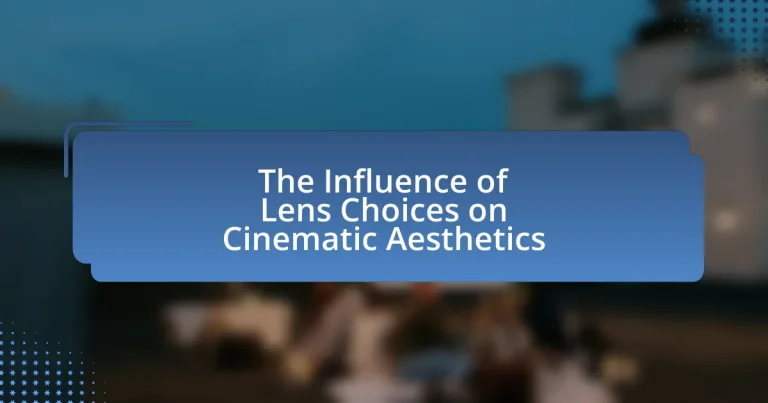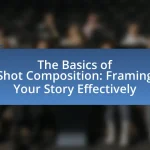The article examines the influence of lens choices on cinematic aesthetics, highlighting how different lenses affect visual composition, depth of field, and the overall mood of a film. It discusses the characteristics of wide-angle and telephoto lenses, their impact on visual storytelling, and how they alter audience perception. Additionally, the article explores technical aspects such as aperture and distortion, emphasizing their role in shaping emotional engagement and narrative depth. Historical examples and practical tips for filmmakers are provided to illustrate the significance of lens selection in achieving desired visual outcomes.
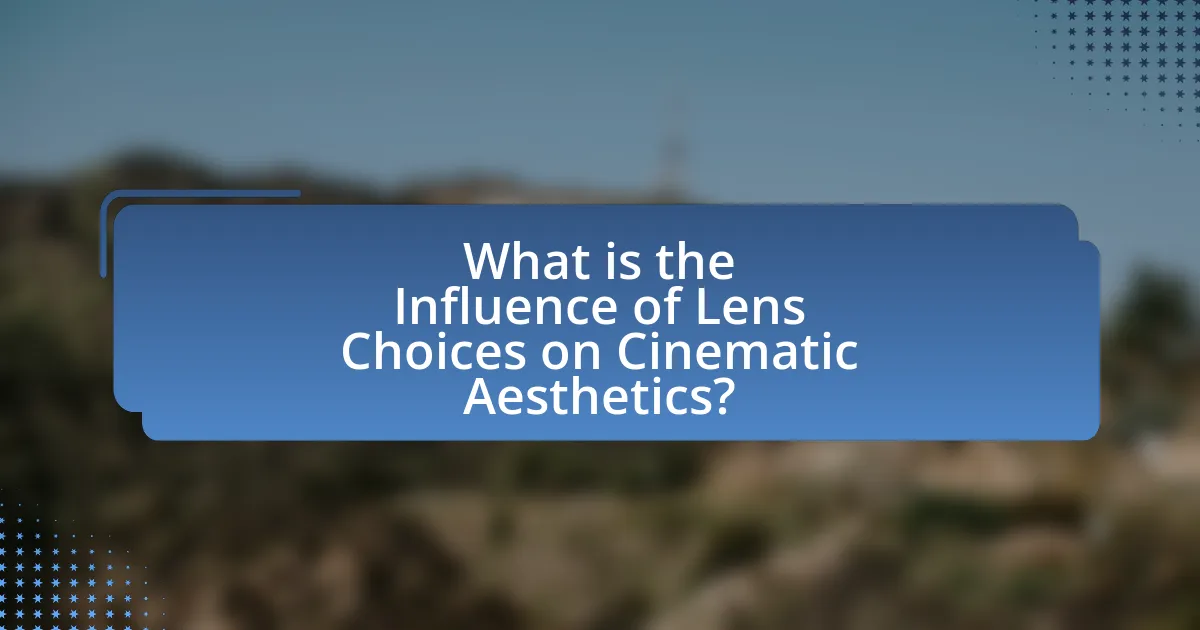
What is the Influence of Lens Choices on Cinematic Aesthetics?
Lens choices significantly influence cinematic aesthetics by affecting the visual composition, depth of field, and overall mood of a film. Different lenses, such as wide-angle, standard, and telephoto, create distinct perspectives and spatial relationships within a scene. For instance, wide-angle lenses can exaggerate depth and create a sense of space, while telephoto lenses compress distances and isolate subjects, impacting how viewers perceive the narrative. Additionally, the choice of lens can alter focus and bokeh, influencing the emotional tone and visual storytelling. Historical examples include the use of anamorphic lenses in classic Hollywood films, which enhanced the epic scale and grandeur of visuals, demonstrating the profound impact of lens selection on cinematic expression.
How do different lens types affect visual storytelling?
Different lens types significantly affect visual storytelling by altering perspective, depth of field, and focal length, which in turn influence how narratives are perceived. For instance, wide-angle lenses create a sense of space and can exaggerate depth, making environments feel larger and more immersive, which is often used in establishing shots to set the scene. Conversely, telephoto lenses compress space and isolate subjects, enhancing emotional intensity by focusing on details and creating a shallow depth of field that blurs the background, drawing attention to the subject.
Additionally, macro lenses allow for extreme close-ups, revealing intricate details that can evoke strong emotional responses, while standard lenses provide a natural perspective that closely resembles human vision, making scenes relatable. The choice of lens thus directly impacts the viewer’s emotional engagement and understanding of the story, as evidenced by filmmakers like Christopher Nolan, who strategically employs different lenses to enhance narrative depth and visual impact in films such as “Inception” and “Interstellar.”
What are the characteristics of wide-angle lenses in film?
Wide-angle lenses in film are characterized by their ability to capture a broader field of view, typically ranging from 24mm to 35mm in focal length. This wider perspective allows filmmakers to include more of the scene within the frame, enhancing spatial relationships and depth. Additionally, wide-angle lenses create a sense of depth by exaggerating the distance between foreground and background elements, which can lead to a more immersive viewing experience. The distortion effect at the edges of the frame is another notable characteristic, often used creatively to emphasize certain aspects of the composition. These features make wide-angle lenses particularly effective for landscape shots, interior scenes, and dynamic action sequences, where capturing a larger context is essential for storytelling.
How do telephoto lenses alter the perception of distance in a scene?
Telephoto lenses compress the perception of distance in a scene, making objects appear closer together than they actually are. This optical effect occurs because telephoto lenses have a longer focal length, which narrows the field of view and reduces the depth of field. As a result, backgrounds and foregrounds seem to merge, creating a flatter perspective. Studies in photography and cinematography confirm that this compression alters spatial relationships, enhancing the visual impact of subjects while diminishing the sense of depth, which is particularly useful in storytelling and framing compositions.
Why is lens choice crucial for cinematographers?
Lens choice is crucial for cinematographers because it directly impacts the visual storytelling and aesthetic quality of a film. Different lenses alter perspective, depth of field, and focal length, which can dramatically change how a scene is perceived by the audience. For instance, wide-angle lenses can create a sense of space and emphasize foreground elements, while telephoto lenses compress distance and isolate subjects, influencing emotional engagement. The choice of lens also affects lighting and composition, as certain lenses may require different lighting setups to achieve the desired effect. This is supported by the fact that iconic films often utilize specific lenses to enhance narrative themes; for example, “The Grand Budapest Hotel” employs a 65mm lens to create a distinct visual style that complements its whimsical storytelling.
What role does lens choice play in establishing mood and tone?
Lens choice significantly influences mood and tone in cinematography by altering perspective, depth of field, and visual emphasis. For instance, wide-angle lenses create a sense of openness and can evoke feelings of vastness or isolation, while telephoto lenses compress space, often generating intimacy or tension. The choice of lens also affects how subjects are framed and perceived; a shallow depth of field isolates the subject, enhancing emotional focus, whereas a deep depth of field can create a more complex, layered narrative. Studies have shown that specific lens characteristics, such as distortion and focal length, directly impact audience perception and emotional response, reinforcing the importance of lens selection in storytelling.
How can lens selection impact audience engagement?
Lens selection significantly impacts audience engagement by influencing the visual storytelling and emotional resonance of a film. Different lenses create varying perspectives, depth of field, and focal lengths, which can evoke specific feelings and reactions from viewers. For instance, wide-angle lenses can enhance a sense of space and inclusion, making audiences feel part of the scene, while telephoto lenses can create intimacy by isolating subjects and drawing attention to details. Research indicates that films utilizing specific lens choices can lead to heightened emotional responses; for example, a study published in the Journal of Visual Culture found that viewers reported stronger emotional engagement when scenes were shot with lenses that emphasized character proximity and emotional expressions. Thus, the choice of lens directly shapes how audiences perceive and connect with the narrative.
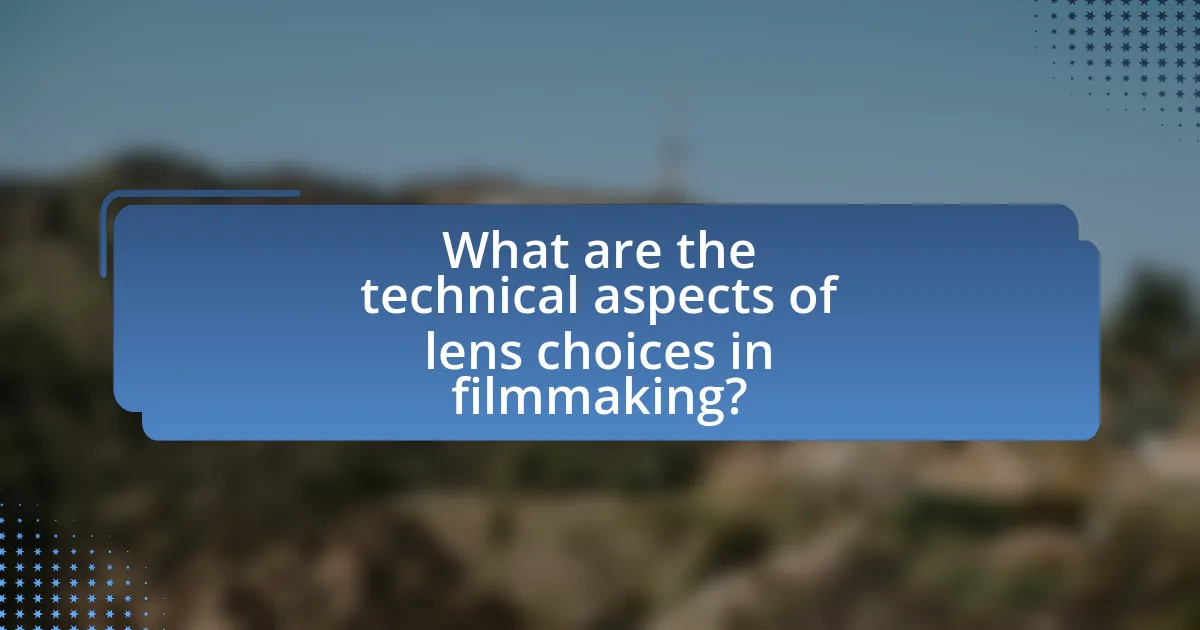
What are the technical aspects of lens choices in filmmaking?
The technical aspects of lens choices in filmmaking include focal length, aperture, lens type, and distortion characteristics. Focal length determines the field of view and perspective; for instance, a wide-angle lens (e.g., 24mm) captures more of a scene but can distort edges, while a telephoto lens (e.g., 200mm) compresses space and isolates subjects. Aperture affects depth of field and exposure; a lower f-stop (e.g., f/1.4) creates a shallow depth of field, enhancing subject isolation, while a higher f-stop (e.g., f/16) increases depth of field, keeping more of the scene in focus. Lens type, such as prime versus zoom, influences image quality and versatility; prime lenses typically offer superior sharpness and lower distortion compared to zoom lenses. Distortion characteristics, including barrel and pincushion distortion, impact the visual representation of subjects and environments, necessitating careful selection based on the desired aesthetic outcome. These technical elements collectively shape the visual storytelling in film, influencing how audiences perceive and engage with the narrative.
How does aperture influence depth of field and focus?
Aperture directly influences depth of field and focus by controlling the amount of light entering the lens and the size of the area in focus. A wider aperture (lower f-stop number) results in a shallower depth of field, which blurs the background and foreground, isolating the subject. Conversely, a narrower aperture (higher f-stop number) increases the depth of field, bringing more of the scene into focus. This relationship is fundamental in photography and cinematography, as it allows creators to manipulate visual emphasis and storytelling through selective focus. For instance, a study published in the Journal of Visual Communication in 2019 demonstrated that varying aperture settings significantly affected viewer perception of depth and focus in cinematic scenes, confirming the critical role of aperture in visual aesthetics.
What is the relationship between aperture size and light exposure?
Aperture size directly influences light exposure in photography and cinematography; a larger aperture allows more light to enter the camera, resulting in brighter images. Specifically, each full stop increase in aperture size (e.g., from f/4 to f/2.8) doubles the amount of light that reaches the sensor. This relationship is crucial for achieving desired exposure levels, especially in varying lighting conditions. For instance, in low-light environments, using a wider aperture can help maintain proper exposure without increasing ISO, which may introduce noise.
How does depth of field affect the viewer’s focus on subjects?
Depth of field significantly influences the viewer’s focus on subjects by controlling the extent of the scene that appears sharp and in focus. A shallow depth of field isolates the subject from the background, drawing the viewer’s attention directly to it, while a deep depth of field keeps more elements in focus, allowing for a broader context but potentially diffusing attention across multiple subjects. This technique is widely used in cinematography; for instance, filmmakers often employ a shallow depth of field to emphasize a character’s emotional state, as seen in films like “The Social Network,” where close-ups with blurred backgrounds enhance the viewer’s connection to the subject.
What are the effects of lens distortion on cinematic visuals?
Lens distortion significantly alters cinematic visuals by affecting the perception of space and depth within a frame. This distortion can create a sense of exaggerated perspective, making objects appear warped or stretched, which can enhance dramatic effects or convey emotional states. For instance, barrel distortion causes straight lines to curve outward, while pincushion distortion makes them curve inward, both of which can impact the viewer’s focus and interpretation of the scene. Studies in cinematography highlight that filmmakers often use these distortions intentionally to evoke specific feelings or to stylize a narrative, demonstrating that lens choice directly influences the aesthetic and emotional impact of visual storytelling.
How can distortion be used creatively in storytelling?
Distortion can be used creatively in storytelling by altering perceptions of reality, enhancing emotional impact, and emphasizing themes. For instance, filmmakers often employ wide-angle lenses to create exaggerated perspectives, which can evoke feelings of disorientation or unease, effectively mirroring a character’s psychological state. This technique is evident in films like “The Blair Witch Project,” where distortion contributes to the sense of fear and confusion. Additionally, distortion can symbolize the subjective nature of truth, as seen in “Eternal Sunshine of the Spotless Mind,” where visual distortions reflect the fragmented memories of the characters. Such creative uses of distortion not only enrich the narrative but also engage the audience on a deeper emotional level.
What are the common types of lens distortion filmmakers encounter?
Filmmakers commonly encounter barrel distortion, pincushion distortion, and mustache distortion. Barrel distortion causes straight lines to curve outward from the center, often seen in wide-angle lenses. Pincushion distortion, on the other hand, makes straight lines bend inward, typically found in telephoto lenses. Mustache distortion combines elements of both barrel and pincushion distortion, resulting in a wavy effect, frequently observed in certain zoom lenses. These distortions can significantly impact the visual storytelling and aesthetic quality of a film, influencing how audiences perceive the scene.
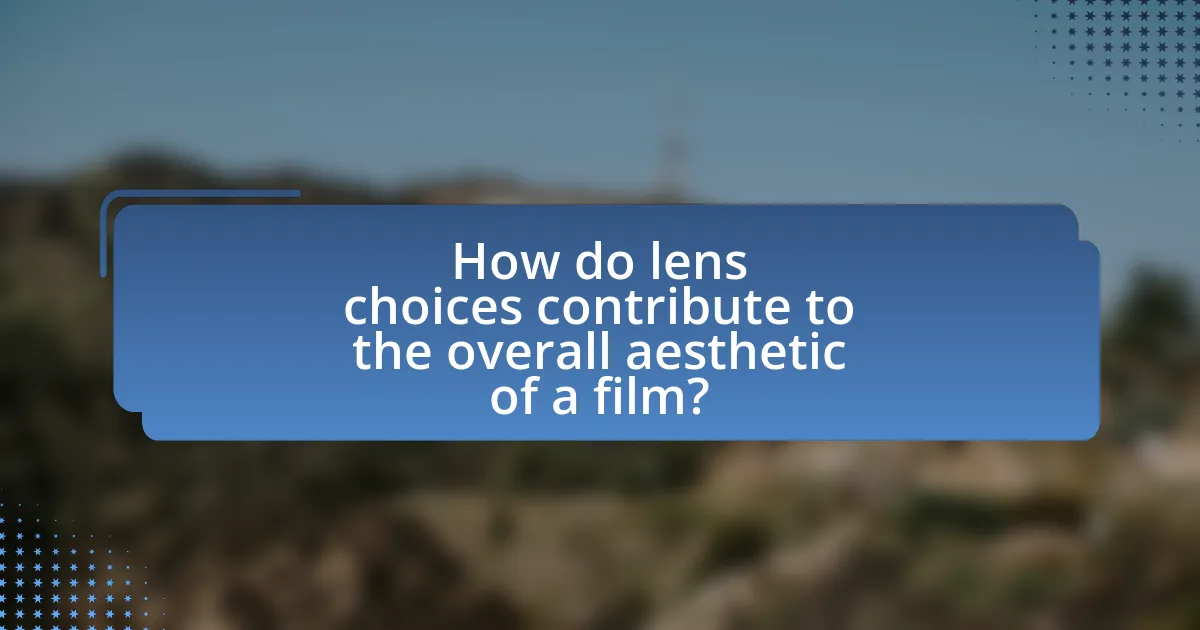
How do lens choices contribute to the overall aesthetic of a film?
Lens choices significantly shape the overall aesthetic of a film by influencing depth of field, perspective, and image distortion. Different lenses, such as wide-angle or telephoto, create varying visual effects; for instance, wide-angle lenses exaggerate spatial relationships, making foreground subjects appear larger and background elements smaller, which can evoke a sense of depth or disorientation. Conversely, telephoto lenses compress space, creating a flatter image that can enhance intimacy or focus on specific details.
Moreover, the choice of lens affects the film’s mood and tone; for example, a shallow depth of field achieved with a fast lens isolates subjects, drawing attention and creating emotional resonance. Historical examples include the use of a 50mm lens in “The Graduate,” which contributed to its iconic visual style by providing a natural perspective while emphasizing character emotions. Thus, lens choices are integral to crafting a film’s visual narrative and emotional impact.
What visual styles can be achieved through specific lens selections?
Specific lens selections can achieve various visual styles in cinematography, including shallow depth of field, wide-angle distortion, and compression effects. For instance, using a prime lens with a wide aperture creates a shallow depth of field, isolating subjects and producing a blurred background, which enhances emotional focus. Conversely, wide-angle lenses can exaggerate perspective, making foreground objects appear larger and creating a sense of space, often used in establishing shots. Telephoto lenses compress distances, making subjects appear closer together, which can intensify dramatic tension in a scene. These effects are well-documented in cinematographic practices, demonstrating how lens choices directly influence visual storytelling and aesthetic outcomes.
How do vintage lenses create a unique aesthetic in modern films?
Vintage lenses create a unique aesthetic in modern films by introducing distinct optical characteristics such as softer focus, unique bokeh, and color rendition that differ from contemporary lenses. These lenses often exhibit imperfections like lens flares, vignetting, and chromatic aberration, which contribute to a nostalgic and organic feel that resonates with audiences. For instance, filmmakers like Quentin Tarantino and Wes Anderson have utilized vintage lenses to evoke specific emotional responses and enhance storytelling through visual texture. The use of these lenses can also reflect a filmmaker’s artistic vision, as seen in films like “The Grand Budapest Hotel,” where the vintage aesthetic complements the film’s whimsical narrative.
What is the impact of lens flares on cinematic imagery?
Lens flares significantly enhance cinematic imagery by adding visual interest and emotional depth. They create a sense of realism and immersion, often evoking feelings of nostalgia or awe. For instance, films like “Star Trek” (2009) utilized lens flares to emphasize futuristic technology and dynamic action, contributing to the film’s overall aesthetic. Additionally, lens flares can serve as a stylistic choice, reflecting the director’s vision and enhancing storytelling by guiding the viewer’s focus. This technique has been widely adopted in modern cinematography, demonstrating its impact on visual narrative and audience engagement.
What practical tips can filmmakers use when selecting lenses?
Filmmakers should consider focal length, aperture, and lens type when selecting lenses to achieve desired cinematic aesthetics. Focal length affects the field of view and perspective; for instance, wide-angle lenses (e.g., 24mm) create a sense of space, while telephoto lenses (e.g., 85mm) compress distance and isolate subjects. Aperture influences depth of field; a lower f-stop (e.g., f/1.8) allows for a shallow depth of field, enhancing subject isolation and creating a cinematic look. Additionally, filmmakers should choose between prime lenses, which offer superior optical quality, and zoom lenses, which provide versatility. These considerations are supported by the fact that lens choice directly impacts visual storytelling, as evidenced by studies showing that different lenses can evoke varying emotional responses in audiences.
How can filmmakers determine the best lens for their narrative needs?
Filmmakers can determine the best lens for their narrative needs by assessing the story’s visual style, emotional tone, and specific shot requirements. The choice of lens affects depth of field, perspective, and framing, which are crucial for conveying the intended message. For instance, a wide-angle lens can create a sense of space and openness, suitable for establishing shots, while a telephoto lens can compress distance and focus on details, enhancing intimacy in character-driven scenes. Research indicates that lens selection significantly influences audience perception and emotional engagement, as demonstrated in studies analyzing viewer responses to different focal lengths in narrative films.
What are common mistakes to avoid when choosing lenses for a project?
Common mistakes to avoid when choosing lenses for a project include selecting lenses without considering the project’s specific visual requirements. Many filmmakers overlook the importance of focal length, which affects composition and depth of field; for instance, using a wide-angle lens for close-ups can distort facial features. Additionally, failing to match lens characteristics with the desired aesthetic can lead to inconsistent visual storytelling. For example, using a lens with a low f-stop for a scene requiring deep focus may result in an unintended shallow depth of field. Lastly, neglecting to test lenses in similar lighting conditions to the project can lead to unexpected results in exposure and color rendition.
